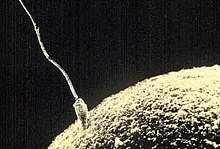Gender segregation

In biology, segregated sex refers to the separation of organisms of one species into different sexes. In botany and mycology this form of sexuality is called diocyte and in zoology as gonochorism .
The basis for segregated sex is the formation of separate male and female gonads and corresponding gametes (germ cells) through gender differentiation . This enables sexual reproduction through the fusion of the germ cells formed in the gonads to form a zygote .
Gonochorism is already pronounced within the multicellular animals (Metazoa) in the sponges (Porifera) and occurs in most animal groups. In some animal groups, in addition to segregated sex, there is also single sex in species that reproduce parthenogenetically .
Two separate sexes do not appear in all species. Hermaphrodites combine male and female characteristics in one individual. Some fish, lizard, and insect species are all female and reproduce through parthenogenesis . In some arthropods , the female sex is forced by infection with bacteria of the genus Wolbachia . In the case of ant populations resulting from hybrids of certain species of ants ( Pogonomyrmex barbatus and P. rugosus ), the fathers of workers and queens are genetically different from one another.
supporting documents
- ↑ a b Gender segregation in: Lexicon of Biology , Spectrum Academic Publishing House, Heidelberg 1999.
- ↑ Cahan S. Helms, L. Keller: Complex hybrid origin of genetic caste determination in harvester ants. In: Nature . July 2003, Volume 424, No. 6946, pp. 306-309, PMID 12867980 .
- ^ J. Whitfield: Everything you always wanted to know about sexes. In: PLoS Biol . June 2004, Volume 2, No. 6 :, Article e183 / Epub. June 15, 2004, PMID 15208728 .